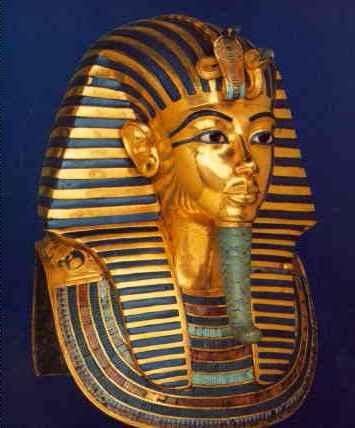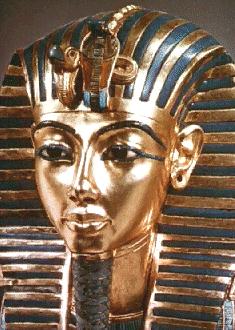|
|
|

 King Tut was a pharoah in the 18th dynasty of ancient Egypt, approximately 1375B.C. His reign
followed the rule of the ninth king of the 18th dynasty, Akenhaten. Tut was only nine years old when
he became pharoah. During much of his reign , his older officials did the ruling. Commander Aye was
his uncle and his private advisor. He helped King Tut until he was sixteen years old. Aye returned Egypt
to polytheism, the belief in many gods and godesses.The cults of the god, Amen, and other gods were
brought back to life. King Tut changed his name from Tutankhaten ("living image of Aten") to
Tutankhamen ("living image of Amen").
King Tut was a pharoah in the 18th dynasty of ancient Egypt, approximately 1375B.C. His reign
followed the rule of the ninth king of the 18th dynasty, Akenhaten. Tut was only nine years old when
he became pharoah. During much of his reign , his older officials did the ruling. Commander Aye was
his uncle and his private advisor. He helped King Tut until he was sixteen years old. Aye returned Egypt
to polytheism, the belief in many gods and godesses.The cults of the god, Amen, and other gods were
brought back to life. King Tut changed his name from Tutankhaten ("living image of Aten") to
Tutankhamen ("living image of Amen").
 Tutankhamen died at the age of 18 and was succeeded by Aye because Tut had no children. Tut was to
be buried at the Valley of the Kings but the rule was that the king's widow had to remarry before the dead
pharoah could be buried. Aye married Queen Anknesamun.
Tutankhamen died at the age of 18 and was succeeded by Aye because Tut had no children. Tut was to
be buried at the Valley of the Kings but the rule was that the king's widow had to remarry before the dead
pharoah could be buried. Aye married Queen Anknesamun.
The biggest concern about King Tuts' death is what caused him to die at such an early age. The first exam of
his body was in 1925 when the mummy was unwrapped and a dark colored lesion was discovered on his left cheek.
His age was determined to be between 18 and 19 when he died. In the time period in which he lived, the average
life span was about 40 years of age. In 1968, using x-ray technology, a bone fragment was found inside Tut's skull.
Along with the cheek lesion, the bone fragment would be consistent with damage caused by a blow to the head.
The most reasonable theory of how he died was that he was killed by someone close to him. Historians feel a real
possible suspect was the General Horemheb,one of Tut's closest advisors, he was also one king away from succeeding
Tutankhamen. Since Tut was a child pharoah, he did not lead Egypt's armies, which allowed General Horemheb to build
control over the army and he knew if Tut got mature enough he would take control of the army himself. Horemheb had
any reference to Tutankhamen removed and replaced with his own name. Horemheb probably killed Tutankhamen and went
on a power grab with the backing of the army. hoping to gain the throne. He would in time become the Pharoah
Zeserkheperure-Setepenre.
 Tut became pharaoh when he was about 9 years old. His reign was not that notable,
mainly because Egypt was actually ruled by elder officials. When Tut died, he was buried in a tomb in the
Valley of the Kings, in Thebes. Several hundred years later his tomb was completely lost when it was covered over with
rubble from the cutting of the tomb for Ramses VI. Yet now, perhaps no pharoah is better known. In 1922, archaeologist
Howard Carter unearthed Tut's tomb and found it to be virtually intact. Since it was covered over it was protected
from grave robbers.
Tut became pharaoh when he was about 9 years old. His reign was not that notable,
mainly because Egypt was actually ruled by elder officials. When Tut died, he was buried in a tomb in the
Valley of the Kings, in Thebes. Several hundred years later his tomb was completely lost when it was covered over with
rubble from the cutting of the tomb for Ramses VI. Yet now, perhaps no pharoah is better known. In 1922, archaeologist
Howard Carter unearthed Tut's tomb and found it to be virtually intact. Since it was covered over it was protected
from grave robbers.

Today the tomb's priceless artifacts fill several galleries in the Egyptian Museum in Cairo. The tomb has not been
emptied of all its treasures. The boy king still lies in his sarcophagus in the tomb's burial chamber. Surrounding
him is art, the walls of the chamber is covered with images and hieroglyphic texts, colored in bright tones over a
yellow background. Three coffins were found in the tomb, the last of solid gold. King Tut was found with 15 rings of
various sizes on his mummy fingers depending on the amount of linen used to wrap his hands. He also had 13 bracelets
and assorted amulets and earrings. Also found among the treasures werre 415 statues of servants complete with baskets
and tools. Three large beds of gold leaf were found that were probably used to prepare the body for embalming.
The beds found with the pharoah were the lion, hippo, and the cow.
Tut was buried in a solid gold coffin, which weighed nearly 2,500 pounds. This coffin was the innermost
of a group of 3 coffins that protected Tut's remains. The lid of the coffin pictured the calm and youthful king. The
golden rays on the headdress identify him with the sun, and the staff he holds symbolizes the god of death and the
afterlife.
 e-mail us if you have any questions.
e-mail us if you have any questions.
This website was created by Zach Moon and John Barrett